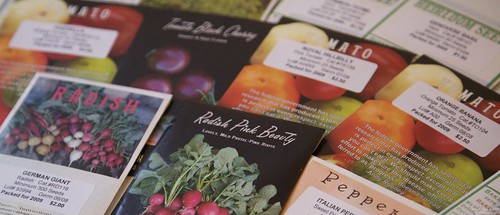Starting your garden can happen many ways. You can get seedlings, or full-blown adult plants from the many DC nurseries, and most of the time, this is a pretty good way to go, but if you really want a good place to start for not a lot of dough, then starting from seed packets is the way to begin.
What kind of seeds should I buy?
Well, I guess that depends on what you want to grow. Assuming you’ve figured out what you’re going to be growing, and you just want to look at seeds, you’ve got a number of choices. You can hit up any garden store or garden section of a hardware store and find seeds, but what about trying something a little more local, and a little more unique? Here are two places we recommend:
This one’s pretty amazing. The people who run Monticello have placed the facility’s garden selection at your disposal. Want to grow something that Jefferson did? They have you covered. The working gardens at Monticello, which once powered Jefferson’s kitchen, and now power local kitchens in the area, are an amazing assortment of over 300 kinds of seeds.
One quick warning, though, as they’re organized by the latin name, it takes a bit of time to go crawling through the listing, even if there are some beautiful photos. Most seed packets run about $2.50, and will cover you for a season or two.
When John handed me the catalog from Baker Creek, I thought I’d died and gone to heaven. The beautifully laid out catalog has over 100 pages of seeds, and it was like shopping in the most amazing candy store. Page after page of tomatoes, radishes in every hue, and even flowers from heirloom varieties that have been around forever.
It’s not that I’m anti-genetic modification, or that I’m particularly all that green, but the flavor of an heirloom tomato, compared to the Flavr-Savr, is like comparing a steak from Ray’s the Steaks to the steak you get at Taco Bell. It’s not the same food, it’s not the same taste, and you can certainly tell which one you enjoy more.
So, what did you get?
Here’s a small listing from each of us:
The Balcony Garden: Danvers Carrots, Cayenne Peppers, Brandywine Tomatoes, French Breakfast Radishes
The Patio Garden: Lincoln Peas, German Giant Radishes, Cherokee Purple Tomatoes, Russian Tarragon, Lemon Basil
The Quarter Acre: Red Potatoes, Black Beauty Zucchini, Genovese Basil, French Lavender
The Farm: Taverna Beans, Blacktail Mountain Watermelon, Black Beauty Zucchini, Spotted Aleppo Lettuce, Early Curled Siberian Kale.
But, why Heirloom?
With our gardens, we’re trying to focus on heirloom varieties of vegetables. In modern agriculture, most plants are chosen because they can be picked by a machine and transported across the country (or in some cases, the ocean) to your local grocery aisle. Heirloom seeds ensure that there’s open pollination, that your plants will go to seed (so you don’t have to buy again next year!) and you get varieties that have long histories of tastiness. Taste is important, but so too are the ability to go to seed from year to year, and open pollination means you get better produce. Grow heirloom. It’s better for your garden, long-term, better for taste, and better for varietal you’re growing.
So, what do you with the seeds now?
Well, there are many options and schools of thought. You can go straight to the ground, and just start planting, and that’s certainly the cheapest way to go, and probably the easiest if you’ve got a lot of space. But, if you’re like John or Tom, and space is at a premium, the seed-starter kit is the way to go. One kit that we’ve had success with is the one from Gardeners.com: the APS Starter Kit, which comes with soil, fertilizer, and trays for growing your seeds, for all of about $50. Now, they recommend using a grow light, which John is going to try this year, while Tom and Ben grow with only sunlight to begin with.
Plant your seeds, get things germinating, and we’ll cover placement, containers, and good soil next time.



